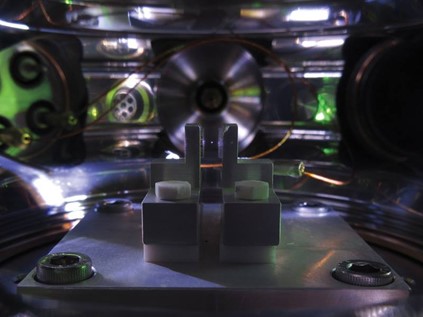The ITER cooling water and heat rejection systems are now ready to support processes that require continuous cooling during testing and commissioning, which the ITER Organization considers “an important moment in the journey that brought together the ITER Organization, ITER India, and industrial partners, and that began in 2016 with the final design review for the cooling water system.”
Hot and cold: The heat behind the wisp of water pictured was generated during helium compressor tests inside ITER’s cryoplant. In the cryoplant, helium gas will be compressed to 21 bar (over 300 psi) by 18 megawatt-class compressors arranged in three trains of six to deliver gaseous helium to three cold boxes. Inside the cold boxes, the helium will reach a temperature of 4.5 K (−269°C). Currently, only a few of the compressors are being tested, but as more come on line, the exothermic process will generate a peak 25 MW of heat.
Cryogenic cooling fluid production could begin next year in service of both the magnet cold test facility and the smaller cryopump test facility, the main elements of which are already in place in the cryoplant.
“The way to the cryoplant operational acceptance testing phase is now open,” said David Grillot, deputy head of the ITER Plant System Program. “The goal will be to demonstrate that the refrigeration system that feeds cooling fluids to the clients inside the tokamak will reach performance requirements.”
Space heating: When the liquid helium plant is fully operational, cooling water will come out of the compressors at a temperature of 100°C. During southern France’s cold season, that flow will be diverted to the hot water boiler building, contributing 12 MW of heat to ITER’s central heating system. That’s about all that is needed to keep the main facilities on the ITER platform at room temperature, according to the ITER organization.
The last of the rings: In other news from ITER, the last of six poloidal field coils recently made its way from the Poloidal Field Coils Winding Facility, where it was manufactured, to a storage facility. There it will await installation in the ITER tokamak assembly pit, the ITER Organization announced April 30. The manufacturing of the ring, and four of the other ITER rings, was managed by Fusion for Energy, the European Domestic Agency for ITER. Poloidal field coil #3 (PF3) is now stored next to its quasi-twin PF4 (both have a diameter of 24 meters) and the smaller PF2, with a diameter of 17 meters. The two bottommost rings, PF6 and PF5, have already been installed in the assembly pit.











